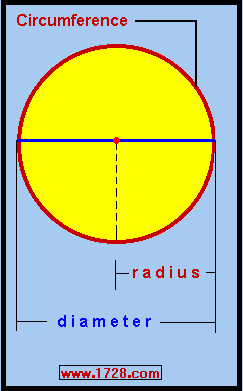|
If you want to calculate the curved distance around a circle (the circumference), it would not be easy to measure with a ruler.  It is much easier to measure the distance of the line (diameter) passing through the center of a circle which also divides the circle into 2 equal sections. The only problem here is determining a number (called π which when multiplied by the diameter would yield the circumference. The early values of "pi", obtained by physically measuring circle circumferences then dividing this by their diameters were not very accurate and no doubt were not much better than 3.
Calculating "pi" by mathematical means is exact but extremely difficult.
As the centuries passed, mathematicians did not get much more accurate values of "pi". Finally, the Dutch mathematician Ludolph Van Ceulen (1540 - 1610) in 1596 calculated "pi" to 20 decimal places and then in 1615 in a paper published posthumously showed his calculation to 35 decimal places. (This required his calculating the perimeter of a polygon with 262 (≈ 4.6 quintillion) sides!!!)
Now, for the first time, the world had an extremely accurate version of "pi". If nothing else, Ludolph's 36 significant figure value of "pi" showed that the chances of "pi" being a repeating decimal were extremely remote. As for calculating "pi", instead of using geometric methods involving polygons, more accurate values were obtained by using infinite series and calculus.
In the next several centuries, more accurate values were produced until 1873, when British mathematician William Shanks calculated "pi" to 707 places. This held the record until 1946 when it was discovered that Shanks made a mistake in calculating the 528th decimal place. Up until the 1940's, all "pi" calculations had been done with paper and pencil. Now, with the advent of computers, the number of decimal places has increased phenomenally. YEAR DECIMAL PLACES 1949 >2,000 1958 >10,000 1961 >100,000 1973 >1,000,000 1989 >1,000,000,000 2002 >1,000,000,000,000 2011 >10,000,000,000,000 2016 >22,000,000,000,000
2019 31,415,926,535,897 (note that this number is "pi" * 1013).
2020 50,000,000,000,000 50 trillion digits!
2021 62,800,000,000,000 62.8 trillion digits!
For example, this formula which just uses simple arithmetic, at first, looks rather easy to solve: Considering that you had to add 50 fractions to get a value of pi accurate to just one decimal digit, we can see that this formula approaches the actual value of pi very slowly.
The problem with the above formula is that we have to calculate 2 transcendental numbers (the arc tangent values) which is not an easy task to do. To read more about calculating the value of "pi" click the link here.
Just how accurate a value of "pi" do any of us require? According to Marc Rayman, NASA only requires a "mere" 15 decimal places of "pi" for their most accurate work.
And just to ensure that the importance of π
is not forgotten, March 14th has been unofficially designated a national holiday.
Sadly, the legendary physicist, Stephen Hawking, passed away on March 14, 2018.
|